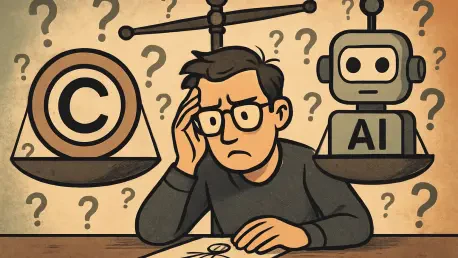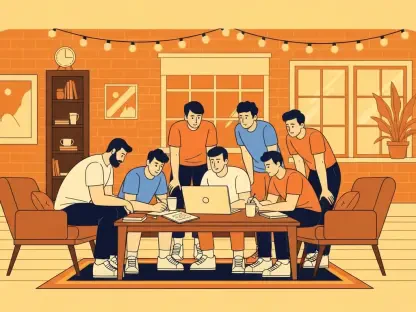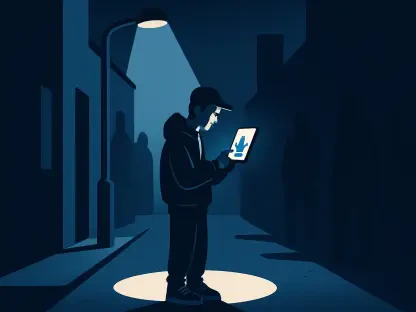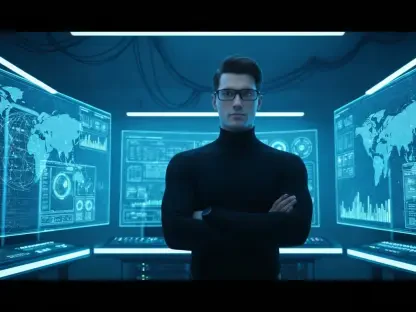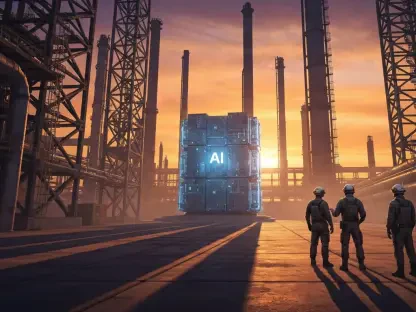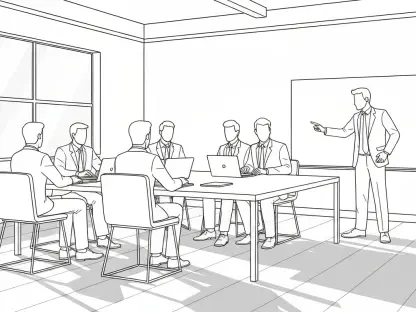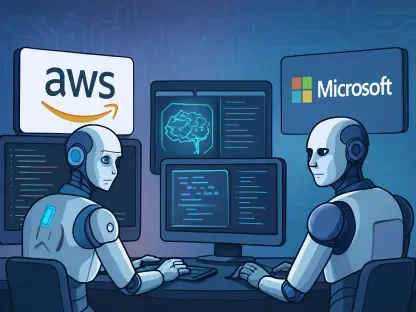Imagine a world where a single click can produce a stunning piece of art or a polished manuscript, yet the creator behind it cannot claim ownership due to legal constraints. This is the reality faced by many leveraging generative artificial intelligence (GenAI) in creative industries today, as the intersection of GenAI and copyright law presents a pressing challenge. Traditional legal frameworks struggle to keep pace with technological innovation, raising critical questions about intellectual property (IP) rights, fair use, and the ethical implications of AI-generated content in the United States.
The purpose of this FAQ article is to provide clear, actionable insights into the complex relationship between GenAI and copyright law. By addressing key concerns and uncertainties, the content aims to guide creators, businesses, and developers through the legal and strategic maze they encounter. Readers can expect to explore pivotal topics such as the copyright eligibility of AI outputs, the controversies surrounding training data, and practical steps for mitigating risks in this evolving landscape.
This discussion is particularly relevant as GenAI tools become integral to content creation across various sectors. The scope covers current legal standards, notable court rulings, and cultural debates, offering a comprehensive look at how these elements shape the creator’s dilemma. Through targeted questions and detailed answers, the article seeks to equip stakeholders with the knowledge needed to navigate these uncharted waters effectively.
Key Questions on GenAI and Copyright Law
What Determines Copyright Protection for GenAI Outputs?
The eligibility of AI-generated content for copyright protection remains a central issue in the legal sphere. Under U.S. law, copyright hinges on the concept of human authorship, meaning that a work must exhibit a sufficient level of human creativity to qualify for protection. The U.S. Copyright Office has consistently emphasized this requirement in its guidelines, particularly in initiatives starting from 2025, clarifying that outputs from GenAI tools often fall short unless significant human input is involved.
This distinction poses a challenge for creators relying on AI for efficiency. For content to be copyrightable, it must either result from detailed human prompts, include distinct human-authored elements, or undergo substantial modification by a person. A historical precedent, such as the Supreme Court’s 1991 ruling in Feist Publications v. Rural Telephone Service, reinforces that even minimal creativity is essential for legal protection. Without this human touch, businesses and individuals risk producing works they cannot legally claim as their own.
While no definitive data quantifies the volume of unprotected AI content, the principle of human authorship continues to guide legal interpretations. Creators are advised to document their contributions meticulously to strengthen claims of originality. This approach underscores the importance of balancing AI assistance with personal creative control to secure IP rights in an uncertain environment.
Is Using Copyrighted Material to Train GenAI Models Considered Fair Use?
Training GenAI models often involves ingesting vast datasets, including copyrighted material, which sparks significant debate over fair use. This doctrine under U.S. copyright law permits limited use of protected works without permission, but its application to AI training data remains inconsistent. The controversy lies in whether such use is transformative and whether it impacts the market value of the original content, key factors courts evaluate in their rulings.
Recent legal cases highlight the ambiguity surrounding this issue. In lawsuits like Kadrey v. Meta Platforms, federal judges have suggested that training on copyrighted works may qualify as fair use if it avoids replicating expressive elements or harming the original creator’s market. However, contrasting outcomes, such as in Thomson Reuters v. Ross Intelligence, indicate that fair use can be denied when AI outputs compete directly with the source material, even in non-generative contexts. These mixed signals create a legal gray area for developers and users alike.
Until clearer standards emerge, the context-specific nature of fair use assessments continues to complicate decision-making. Factors such as the purpose of use, the nature of the copyrighted work, and commercial intent play critical roles in judicial outcomes. Stakeholders must stay informed about evolving case law and consider ethical data-sourcing practices to minimize potential infringement risks while awaiting legislative clarity.
How Does the Creator’s Dilemma Impact Individuals and Businesses?
At the heart of the GenAI and copyright debate lies the creator’s dilemmthe inability to copyright AI-generated outputs while original works may be used to train models without explicit consent. This paradox frustrates creators who seek to harness AI for productivity but find their contributions unprotected. Simultaneously, the potential exploitation of their content for AI development fuels concerns about loss of control over personal IP.
For businesses, this dilemma translates into strategic hurdles. Companies investing in GenAI for marketing or artistic content may discover that they cannot claim ownership of the results, undermining competitive advantages. Moreover, the risk of competitors using publicly available material to train models adds another layer of complexity to IP management. This imbalance between input and output protection shapes how value is perceived in creative industries.
Addressing this conflict requires a nuanced approach, as opting out of data contribution could hinder AI advancements, while blanket licensing of training material remains impractical. The tension between fostering innovation and safeguarding rights persists as a core challenge. Until resolved, stakeholders are encouraged to prioritize human involvement in creative processes to mitigate the impact of this ongoing issue.
What Strategic Steps Can Businesses Take Amid Legal Uncertainty?
Navigating the murky waters of GenAI and copyright law demands proactive strategies for businesses. The lack of definitive legal protection for AI outputs, coupled with risks tied to training data, necessitates careful planning to avoid potential disputes. Companies must adapt to this uncertainty by implementing measures that safeguard their interests while leveraging AI’s benefits.
One effective tactic is to emphasize human co-creation in content development, ensuring that outputs reflect substantial personal input to meet copyright thresholds. Additionally, diversifying IP protection methods, such as trademarks or trade secrets, can provide alternative safeguards. Auditing the sources of training data and staying updated on regulatory changes also help in reducing exposure to infringement claims, especially for enterprise users.
Some GenAI providers offer indemnification programs to shield clients from third-party legal challenges, though these often come with limitations and may not extend to smaller entities. Documenting creative processes meticulously serves as another practical step to establish authorship claims. By adopting such strategies, businesses can better position themselves to thrive despite the unresolved legal landscape surrounding AI content.
What Ethical and Cultural Concerns Arise from GenAI in Creative Fields?
Beyond legalities, the use of GenAI in creativity raises profound ethical and cultural questions. Many in artistic communities worry that AI-generated works diminish the value of human craftsmanship, a sentiment echoed by prominent figures like Hayao Miyazaki of Studio Ghibli. His criticism of AI art as an affront to life itself reflects a broader unease about technology’s role in replacing personal expression.
This cultural pushback is evident in controversies over AI mimicking iconic styles or works without regard for original intent. Such practices spark debates about authenticity and the spirit of creativity, particularly when AI outputs flood markets traditionally dominated by human talent. The concern is not just about legal ownership but also about preserving the essence of artistic endeavor in an increasingly automated world.
These ethical dimensions complicate the adoption of GenAI, as stakeholders grapple with balancing efficiency against cultural integrity. Public sentiment often leans toward valuing human-made works, influencing how AI is perceived in creative sectors. Addressing these concerns requires sensitivity to societal values, ensuring that technology complements rather than overshadows the human element in art and innovation.
What Potential Solutions Exist for Resolving Copyright Issues with GenAI?
Finding a resolution to the copyright challenges posed by GenAI is a pressing need, with various proposals under consideration. Licensing frameworks, as explored by the U.S. Copyright Office starting from 2025, represent one potential path, though they risk favoring large corporations with greater resources. Such systems aim to formalize permissions for training data but face logistical and financial hurdles at scale.
Alternative perspectives, including opposition to mandatory licensing by political figures like President Trump, advocate for AI to draw freely from a collective pool of knowledge. In contrast, the European Union’s exceptions for text and data mining provide a different model, allowing certain uses without explicit consent under specific conditions. However, the U.S. has yet to adopt similar reforms, leaving the future of such solutions uncertain.
Pending clearer regulations, interim measures like voluntary agreements between creators and developers could bridge gaps. Encouraging transparency in data usage and fostering dialogue among stakeholders might also pave the way for equitable policies. Until a cohesive framework emerges, staying proactive with risk mitigation remains essential for navigating the current ambiguities in copyright law.
Summary of Key Insights
This FAQ addresses the intricate challenges at the nexus of GenAI and copyright law, offering clarity on critical issues. It highlights that AI-generated content often lacks copyright protection without significant human authorship, as upheld by legal standards. The unresolved status of fair use for training data, evidenced by conflicting court rulings, continues to create uncertainty for developers and creators alike.
Further insights reveal the creator’s dilemma as a fundamental conflict, impacting how IP is valued in creative spaces. Strategic adaptations for businesses, ethical concerns in cultural contexts, and potential solutions like licensing frameworks are also explored as vital considerations. These points collectively underscore the dissonance between technological progress and outdated legal structures.
For those seeking deeper understanding, exploring resources from the U.S. Copyright Office or following updates on relevant case law can provide additional context. Engaging with industry discussions on AI ethics may also enrich perspectives on balancing innovation with cultural values. This summary encapsulates the essential takeaways, equipping readers to approach GenAI’s legal landscape with informed caution.
Final Thoughts
Reflecting on the complexities discussed, it becomes evident that the integration of GenAI into creative processes has reshaped traditional notions of ownership and authorship. The journey through legal uncertainties and cultural debates reveals a landscape fraught with challenges yet ripe with opportunity for those willing to adapt. The persistent gap between technology and law underscores an urgent need for updated frameworks that can accommodate AI’s unique capabilities.
Moving forward, stakeholders are encouraged to take actionable steps, such as prioritizing human creativity in AI-assisted works and advocating for clearer regulations through industry collaboration. Exploring hybrid models of IP protection and engaging with emerging legislative proposals offer a way to stay ahead of potential pitfalls. These strategies provide a foundation for safeguarding interests while embracing innovation.
Ultimately, the evolving dialogue around GenAI and copyright law invites everyone to consider their role in shaping a balanced future. By staying informed and proactive, individuals and businesses alike can contribute to a system that honors both technological advancement and the enduring value of human expression. This reflection serves as a call to navigate personal and professional endeavors with an eye toward equitable solutions.
